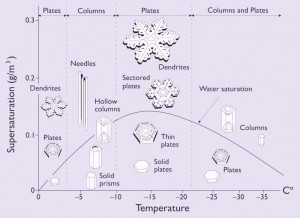
Photo taken from snowcrystals.com
We are all taught at a very young age that every snowflake, much like a zebra or a fingerprint, is unique. However, despite being told that no snowflake is like another, we are never told why. In order to determine why each snowflake is unique, let’s look at snowflakes with more detail, and let’s discuss how a drop of water is transformed into a snowflake in the first place.
Through the observation of close-up photographs, it can be seen that snowflakes come in many different shapes and sizes; needles, columns, dendrites (the “perfect” snowflake) are among the many forms that they can take. The key factors that determine the final geometry of a snowflake are the temperature and relative humidity of the air. Data compiled by the Alaska Satellite Foundation plots just how a snowflake’s form varies due to these factors.
Now that we are beginning to understand some factors determining the variation of snowflakes, we can start to explore the formation of the crystal itself. The first ingredient to a snowflake is its nucleus. The snowflake nucleus is essentially a dust or pollen particle, or ice crystal that resides high in the atmosphere.

Geometric patterning of snowflake formation due to variance in temperature and humidity.
Photo from http://www.thenakedscientists.com
As it passes through a nimbus cloud, water molecules begin to aggregate onto the nucleus and form the familiar hexagonal shape of a snowflake. As the young snowflake descends, water molecules continue to condense onto the flake, creating the branches.
The following video from the popular YouTube channel “It’s Okay To Be Smart” illustrates the geometric reasoning behind the hexagonal shape of a snowflake on a molecular level.

Link: https://www.youtube.com/watch?v=fUot7XSX8uA
It is evident that there is a great deal of structure and order in a snowflake, but there is also a random, almost chaotic, influence in its design. The understanding that scientists have gained from snowflakes has been a valuable asset in many studies. For example, this study published by the American Physical Society (AMS) in 2004 compares the growth of a macromolecule by sedimentation with the formation of a snowflake.
So, next time you are out for a peaceful walk in the snow and a snowflake lands on your hand, you can truly appreciate what goes into its formation.
By: Kia Sanjabi
References
- Westbrook, C. D., Ball, R. C., Field, P. R., & Heymsfield, A. J. (2004). Theory of growth by differential sedimentation, with application to snowflake formation. Physical Review E, 70(2), 021403.
- Zentile, C. (2007). The Science of Snowflakes, Are no two ice-crystals alike? Retrieved 01/27, 2014, from http://www.thenakedscientists.com/HTML/articles/article/science-of-snowflakes/
